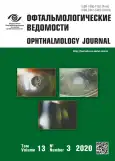影响上睑下垂患者行上睑板肌切除术的主要预后因素
- 作者: Goltsman E.V.1, Potemkin V.V.2, Davydov D.V.3
-
隶属关系:
- City Multidisciplinary Hospital No. 2
- City Multidisciplinary Hospital No. 2, Academican I.P. Pavlov First St. Petersburg State Medical University of the Ministry of Healthcare of the Russian Federation
- Peoples’ Friendship University of Russia
- 期: 卷 13, 编号 3 (2020)
- 页面: 7-12
- 栏目: Original study articles
- ##submission.dateSubmitted##: 15.03.2020
- ##submission.dateAccepted##: 19.09.2020
- ##submission.datePublished##: 08.01.2021
- URL: https://journals.eco-vector.com/ov/article/view/25740
- DOI: https://doi.org/10.17816/OV25740
- ID: 25740
如何引用文章
详细
经结膜入路矫正上睑下垂的方法已经越来越普遍。然而,其广泛应用主要约束是因为没有明确的手术切除量的标准,尤其是对去氧肾上腺素检测反应呈阴性的患者。
目的. 评估影响上睑板肌(STM)切除术的一些因素。
材料和方法. 研究过程中对75例(103只眼睑)接受手术治疗上睑下垂的患者进行了检查。根据去氧肾上
腺素(PE)的测试结果将患者分为2组。第一组包括PE测试呈阳性的患者,第二组包括PE测试呈弱阳性的患者。所有的患者均接受了“开放天空”式STM切除术,在某些情况下还结合上睑板切除。
结果. PE测试和白线活动度会影响STM切除术的结果,而其他因素则不会。
结论. PE测试和白线活动度对上睑下垂矫正方法的选择具有重要意义。
全文:
引言
上睑下垂的治疗是现代眼睑整形术中最具争议的领域之一,这是由于缺乏明确的标准来选择手术矫正方法。大多数专家在选择治疗方法时注意的主要因素是上睑提肌(LPS)的功能和上睑下垂的程度。因此,严重程度的上睑下垂和LPS功能差(≤4mm)是额肌瓣悬吊术的适应症[1–4]。但对于上睑板肌(STM)或上睑提肌腱膜切除术,那就模棱两可了,因为这两种方法都适用于中度或轻度上睑下垂和LPS功能优良和良好。
在外科治疗上睑下垂的方法中经结膜入路始于1961年(Fasanella-Servat手术) [9–11]。在这段时期内,该方法经过了多次修改。在2003年,S.Lake等人提出了最新的修改方案之一[7]。关于计算STM切除量的算法有很多,最常用的算法是J.D.Perry[12] S.C.Dresner[8]以及S.Lake[7]等人提出的。论著作者先前提出了上睑板肌切除术的新算法,其主要区别在于在去氧肾上腺素(PE)测试呈阴性和弱阳性的情况下,进行了术中白线活动度的评估以确定是否行上睑板肌切除术及其切除量[15]。因此,毫无疑问,寻找其他影响上睑板肌切除术预测结果的因素是有必要的[5,6]。
研究目的是评估PE测试、白线活动度、STM被切除的长度以及上睑提肌的功能对轻度和中度上睑下垂且LPS功能良好或优良的患者行经结膜入路STM切除术结果的影响。
材料和方法
研究组中对75例(103只眼睑)轻度和中度上睑下垂的患者进行了检查,这些患者是在2017年11月到2019年8月被圣彼得堡市第二综合医院第5眼科室收纳入院的。
患者排除标准为:
重度上睑下垂;创伤性或神经源性上睑下垂;
伴有LPS功能差或中等的上睑下垂(8mm及更小);
有导致上睑下垂的外伤史;
先前进行过上睑下垂的矫正手术,或任何需要放开睑器的手术;
做过各种抗衰老措施(如肉毒杆菌疗法,永久性化妆及假睫毛等)。
将患者分为2组,分组依据是PE测试结果。按照常规方法进行了PE测试[11,19]:将2.5%的去氧肾上腺素溶液(Irifrin,Sentis,瑞士)以5分钟为间隔2次滴入结膜上穹[12]。在滴注前和最后一次滴入去氧肾上腺素后5分钟进行MRD1测量(从角膜反射中心到上眼睑边缘的间隔,以毫米为单位)。PE测试结果评估如下:如果2.5%的去氧肾上腺素在滴注前和滴注后,其MRD1的差异为0-0.5mm,则该测试被认为是阴性,若为1-1.5mm,则为弱阳性,若≥2mm,则为阳性[14, 20]。
第一组的患者均对PE测试呈阳性
(«+»)(37名患者,50只眼睑),第二组的患者均对PE测试呈阴性和弱阳性(«–»和«+/–»)(38名患者,53只眼睑)。第一组患者的平均年龄为 62.6 ± 8.6 岁,第二组患者的平均年龄为 64.6 ± 7.8岁(р = 0.52)。在第一组中,男性约占比37.8%,女性约占比62.2%。在第二组中,男性占比55.2%,女性占比44.8%(р = 0.1)。
根据先前提出的方法,对所有患者均进行了改良的STM切除术,下面将会详细描述。选择以下几点作为影响STM切除术结果的因素:PE测试,上睑板肌被切除的长度,白线的活动度和LPS的功能。
改良的上睑板肌切除术的操作方法
用消毒液对脸部皮肤进行消毒后,上眼睑中部作一牵引缝线(vicryl 4.00)。然后,借助眼睑拉钩(Desmarres)翻转上眼睑(图1,a)。用1.0ml 0.94 %的等渗氯化钠对上睑肌进行水分离后(图1,b),结膜连同STM从睑板上缘切开并通过钝性分离(图1,c,d),下一步是评估STM长度和白线活动度。
图. 1. 改良的上睑板肌切除术操作步骤:a-d 详述见文中
上睑板肌长度的评估方法
图. 2. 上睑板肌切除长度的测量
上睑板肌分离后,通过使用手术测量仪测量了它的中心长度。
白线活动度的评估方法
白线暴露后,沿肌肉纤维方向牵拉STM腹部中心,直至不能移动为止,使用眼用测量尺对其活动性进行了评估(图3)。
图. 3. 白线移动度的评估
接下来将STM切除至计划值(图4,e)。
用U型缝线(vicryl 6.0)将STM残端缝合在睑板边缘(图4,f)。通过连续缝合(vicry l 6.0)的方法将结膜缝合在睑板上,并且缝合线不暴露在外面(图4,g)。鉴于缝合线是可吸收的,因此术后不需要拆线。
图. 4. 改良的上睑板肌切除术操作步骤:(续图1)
术前对LPS的功能进行了评估,其方法为检查者用拇指沿眉毛长轴方向按压住额肌后,让患者先向下看,再向上看,测量上睑移动的距离(以毫米为单位)。使用IBM SPSS Statistics 23 软件进行统计分析。计算定量指标的平均值和标准差。为了评估参数之间的线性关系,进行了相关分析(Spearman相关系数)。
图. 5. 去氧肾上腺素呈阴性患者行改良的上睑板肌切除术的临床实例:а—测试前;b—测试后;c—术中上睑板肌的长度测量;d—外科治疗后
结果
在对获得的结果分析之前,有必要先讨论两个不同的概念:整个手术结果和STM切除结果,鉴于在该研究中主要评估STM切除术的影响因素,也适用STM联合睑板切除的情况。在这种情况下,为了计算手术结果,从所得的结果(以毫米为单位)减去睑板的切除量(以毫米为单位)。该研究所得的结果是术后6个月后进行的评估。因此,PE测试呈阳性的组中,STM的切除量平均为 2.74 ± 1.0mm,而PE测试呈阴性或弱阳性的组中,STM的平均切除量为 2.46 ± 0.66mm(p = 0.098)。表中列出了获得的数据。
各组所得的数据分布 Distribution of received data in groups | |||
参数 | 分组 | 可信度,p | |
去氧肾上腺素测试 | 去氧肾上腺素测试呈弱阳性和阴性反应, n = 53 | ||
术前上睑下垂的程度,mm | 3.3 ± 0.9 | 3.5 ± 0.8 | 0.19 |
STM切除术结果,mm | 2.74 ± 1.0 | 2.46 ± 0.66 | 0.098 |
去氧肾上腺素测试,mm | 2.18 ± 0.18 | 0.6 ± 0.5 | <0.0001 |
LPS功能,mm | 13.4 ± 2.0 | 13.6 ± 1.7 | 0.61 |
STM被切除长度,mm | 12.8 ± 3.4 | 12.6 ± 2.6 | 0.35 |
白线活动度,mm | 1.78 ± 1.0 | 2.0 ± 0.7 | 0.56 |
备注. n—眼睑数量;STM—上睑板肌;LPS—上睑提肌。 | |||
PE测试呈阳性组的平均数据为2.18 ± 2.3mm,而PE测试呈阴性或弱阳性组的平均数据为 0.6 ± 0.5mm(p < 0.0001)。根据Chaddock量表,各组的手术矫正结果与PE测试之间存在中度相关性(分别为R = 0.31,p = 0.03和R = 0.33,p = 0.018)(见表)。
第一组LPS功能平均为13.4 ± 2.0mm,第二组LPS功能平均为13.6 ± 1.7mm(p = 0.61)(见表)。两组均未显示STM的切除量取决于LPS的功能(第一组R = 0.042,p = 0.77和第二组R = 0.15,p = 0.274)。
第一组上睑板肌被切除的平均长度为12.8 ± 3.4mm,第二组的平均长度为12.6 ± 2.6(p = 0.35)。两组中被切除的上睑板肌的长度均不影响手术结果(第一组R = –0.01,p = 0.945和第二组 R = –0.24,p = 0.081)(见表)。
第一组白线活动度平均为 1.78 ± 1.0mm,而第二组的平均为2.0 ± 0.7mm(p = 0.56) (见表)。第二组数据的结果显示,STM切除量明显取决于白线活动度(第一组 R = 0.02,p = 0.99和第二组 R = 0.72,p = 0.0005)。
举例说明,PE测试呈阴性的患者行STM切除术的临床实例(见图5)。患者H,75岁,以左眼上睑下垂为主诉就诊(见图5,a)。检查:睑裂中部的宽度为 5mm,上睑下垂的程度为3mm,LPS的功能为14mm,PE测试呈阴性(0mm)(见图5,c)。术中:白线移动度为3mm,STM长度为 19mm(见图5,c)。患者接受了STM次全切除术。通过这种方法完全矫正了上睑下垂,手术结果为3mm(见图5,d)。
讨论
长期以来,PE测试一直是外科医生在选择治疗上睑下垂手术方案时要注意的主要因素。该测试在1979年因R.K.Dortzbach而闻名,R.K.Dortzbach在自己的研究中描述了应用去氧肾上腺素评估STM切除术可行性的可能性[15]。越来越多的作者对不同PE测试反应结果的患者行STM切除术表示认同[7,16,17]。
由于PE测试的广泛应用,我们决定评估STM切除术对其结果的主要依懒性。所获得的数据表明根据Chaddock量表两组均存在中度相关性(第一组R = 0.31,p = 0.03和第二组R = 0.33,p = 0.018)。这表明,在决定是否行STM切除术时,当然需要进行PE测试,但前提是要考虑其他因素。
STM被切除的长度和LPS的功能不影响STM切除术的结果。
E.A.Vanderson等人将“白线”概念引入实践中的时间并不长[18],在他们的研究中无论从宏观角度还是组织学角度都证明了该区域是LPS的横纹肌纤维到STM平滑肌的过渡。根据我们的数据,在第一组中,评估发现白线活动度对STM切除的结果没有任何影响,而第二组中显示出较高的依赖性(分别为R = 0.02,p = 0.99和 R = 0.72,p = 0.0005)。因此,在PE测试呈阴性或弱阳性的情况下,白线活动度的评估是非常有必要的。此外,该评估有可能是此类患者是否行STM切除术的主要因素。
结论
决定采取何种方法矫正上睑下垂和切除量必须基于多种综合因素,比如去甲肾上腺素测试结果及白线移动度的程度。
作者简介
Elena Goltsman
City Multidisciplinary Hospital No. 2
编辑信件的主要联系方式.
Email: ageeva_elena@inbox.ru
ophthalmologist
俄罗斯联邦, Saint PetersburgVitaly Potemkin
City Multidisciplinary Hospital No. 2, Academican I.P. Pavlov First St. Petersburg State Medical University of the Ministry of Healthcare of the Russian Federation
Email: potem@inbox.ru
PhD, Assistant Professor. Department of Ophthalmology; Ophthalmologist
俄罗斯联邦, Saint PetersburgDmitriy Davydov
Peoples’ Friendship University of Russia
Email: d-davydov3@yandex.ru
MD, PhD, DMedSc, Professor, Head of Department, Reconstructive Surgery Department with Ophthalmology Course
俄罗斯联邦, Moscow参考
- Finsterer J. Ptosis: causes, presentation, and management. Aesth Plast Surg. 2003;27(3):193-204. https://doi.org/10.1007/s00266-003-0127-5.
- Edmonson BC, Wulc AE. Ptosis evaluation and management. Otolaryngol Clin N Am. 2005;38(5):921-946. https://doi.org/10.1016/j.otc.2005.08.012.
- Crawford JS. Repair of ptosis using frontalis muscles and fascia lata a 20-year review. Ophthalmic Surg. 1977;8(4):31-40.
- Rycroft BW. The transconjunctival and transcutaneous approach to levator resection in the treatment of ptosis. In: Troutman R, Converse J, Smith B, editors. Plastics and reconstructive surgery of the eye and adenexa. London: Butter-worth; 1962.
- Patel V, Salam A, Malhotra R. Posterior approach white line advancement ptosis repair: the evolving posterior approach to ptosis surgery. Br J Ophthalmol. 2010;94(11):1513-1518. https://doi.org/10.1136/bjo.2009.172353.
- Ichinose A, Leibovitch I. Transconjunctival levator aponeurosis advancement without resection of Müller’s muscle in aponeurotic ptosis repair. Open Ophthalmol J. 2010;4:85-90. https://doi.org/10.2174/1874364101004010085.
- Lake S, Mohammad-Ali FH, Khooshabeh R. Open sky Müller’s muscle-conjunctiva resection for ptosis surgery. Eye. 2003;17(9):1008-1012. https://doi.org/10.1038/sj.eye.6700623.
- Dresner SC. Further modifications of the Müller’s muscle-conjunctival resection procedure for blepharoptosis. Ophthal Plast Reconstr Surg. 1991;7(2):114-122. https://doi.org/10.1097/00002341-199106000-00005.
- Beard C. History of ptosis surgery. Adv Ophthalmic Plast Reconstr Surg. 1986;5:125-131.
- Fasanella R, Servat J. Levator resection for minimal ptosis. Another simplified operation. Arch Ophthalmol. 1961;65:493-496. https://doi.org/10.1001/archopht.1961.01840020495005.
- Putterman AM, Urist MJ. Müller muscle-conjunctiva resection. Technique for treatment of blepharoptosis. Arch Ophthalmol. 1975;93(8):619-623. https://doi.org/10.1001/archopht.1975. 01010020595007.
- Perry JD, Kadakia A, Foster JA. A new algorithm for ptosis repair using conjunctival Mullerectomy with or without tarsectomy. Ophthal Plast Reconstr Surg. 2002;18(6):426-429. https://doi.org/10.1097/00002341-200211000-00007.
- Потёмкин В.В., Гольцман Е.В. Интраоперационный тест оценки подвижности белой линии при трансконъюнктивальной резекции верхней тарзальной мышцы по поводу блефароптоза // Офтальмологические ведомости. – 2019. – Т. 12. – № 4. – C. 87–91. [Potyomkin VV, Goltsman EV. White line motility test in transconjunctival muellerectomy for blepharoptosis. Ophthalmology journal. 2019;12(4):87-91. (In Russ.)]. https://doi.org/10.17816/ov15811.
- Потёмкин В.В., Гольцман Е.В. Новый алгоритм планирования резекции верхней тарзальной мышцы при блефароптозе: описание методики и результаты // Офтальмологические ведомости. – 2019. – Т. 12. – № 3. – С. 83–90. [Potyomkin VV, Goltsman EV. New algorithm for planning superior tarsal muscle resection for blepharoptosis: description of technique and results. Ophthalmology journal. 2019;12(3): 83-90. (In Russ.)]. https://doi.org/10.17816/ ov16049.
- Dortzbach RK. Superior tarsal muscle resection to correct belpharoptosis. Ophthalmology. 1979;86(10):1883-1891. https://doi.org/10.1016/s0161-6420(79)35341-6.
- Baldwin HC, Bhagey J, Khooshabeh R. Open sky Muller muscle conjunctival resection in phenylephrine test-negative blepharoptosis patients. Ophthal Plast Reconstr Surg. 2005;21(4):276-280. https://doi.org/10.1097/01.iop.0000167789.39570.3e.
- Peter NM, Khooshabeh R. Open-sky isolated subtotal Muller’s muscle resection for ptosis surgery: a review of over 300 cases and assessment of long-term outcome. Eye (Lond). 2013;27(4): 519-524. https://doi.org/10.1038/eye.2012.303.
- Vanderson EA, Fatima CS, de Ary-Pires B, et al. The human superior tarsal muscle (Müller’s muscle): a morphological classification with surgical correlations. Anat Sci Int. 2010;85(1):1-7. https://doi.org/10.1007/s12565-009-0043-0.
- Glatt HJ, Fett DR, Putterman AM. Comparison of 2.5% and 10% phenylephrine in the elevation of upper eyelids with ptosis. Ophthalmic Surg. 1990;21(3):173-176.
- Grace Lee N, Lin L-W, Mehta S, Freitag SK. Response to phenylephrine testing in upper eyelids with ptosis. Digit J Ophthalmol. 2015;21(3):1-12.
补充文件












